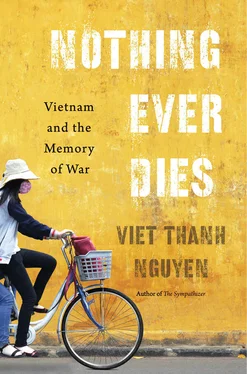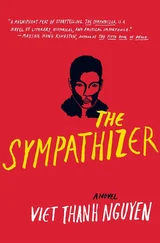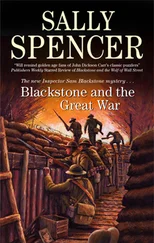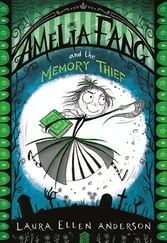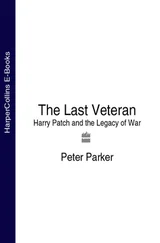In the more typical true war story, the reader does not see himself as enduring being killed or raped, only being the witness to such acts, which itself may be an awful experience. Tim O’Brien’s stories are closer to this rule, an antiwar true war story that nevertheless can be assimilated into a reader’s patriotic, masculine imagination. A scene is repeated again and again: a mine blows a soldier into a tree, leaving his guts hanging from the branches for his comrades to retrieve — horrible, but expected, for this is war. In returning to this scene, O’Brien follows the logic of the ghost story laid down by Hayslip. She writes that “the teller must always specify how the victim died, usually in great detail.… Because the manner of death influences each person’s life among the spirits, the teller cannot leave out any detail, especially if the death had been sudden and violent.” 5The reader sees herself or himself as the soldier watching this happen, the survivor, not as the soldier who has been dismembered, liquefied, and turned into a ghost, if the writer or the reader believes in ghosts. The reader does not identify with those who die, the ghosts, because then the story would end, unless one tells ghost stories. In the type of true war story that is not a ghost story, the soldier who tells the story lives on, perhaps to suffer, but still alive to bear witness. This type of war story, the most common one in America and elsewhere, is bracketed by the extremes of rape versus banality, the erotic drive of the war machine versus its bland ideological face.
Both exist at the fringes of war memory, for as difficult as rape is to imagine or remember, banality is too boring to be recalled. Most Americans who served in the military during the war never saw combat, serving on ships, guarding bases, delivering supplies, pushing paper, condemned as “rear echelon motherfuckers” in the rich lingo of the combat troops. The epithet is meant to satirize their cowardice and privilege, and perhaps the envy of the combat troops, but something else lurks in the obscenity — the dim realization that contemporary war is a bureaucratic and capitalistic enterprise that requires its bored clerks, soulless administrators, ignorant taxpayers, contradictory priests, and encouraging families. If we understood that a war machine is a pervasive system of complicity that requires not only its front line troops but also its extensive network of logistical, emotional, and ideological support, then we would understand that all the politicians and civilians who cheer the war effort or simply go along with it are, one and all, rear echelon motherfuckers, including, perhaps, myself.
The obsidian myth of the heroic warrior allows rear echelon motherfuckers to see themselves as red-blooded patriots from the heartland. That myth took a near-fatal wound during the war for Americans, who tried to repair it by turning soldiers who were not seen as heroic warriors into wounded warriors. But soldiers are not warriors in the mythic sense, where every able-bodied man had a spear or battle-axe in his home, ready for the call to arms. Instead the rank-and-file soldier is a manifestation of the modern era, faceless, anonymous, at once an individual and a part of a mass, representing the entire nation. A true war story must not be only about what happens to combat soldiers and their guts, but also about the nation and its guts, about running one’s refrigerator, which might use a refrigerant made by Dow Chemical, the company that manufactured Agent Orange. This herbicide debilitated thousands of American soldiers and their progeny, as the U.S. government admitted, and also thousands of Vietnamese and their offspring, as the U.S.overnment will not admit. The quotidian story about opening one’s refrigerator and peering into its guts, stuffed with the plastic-packaged wonders of capitalist life, is just as true as and arguably more unsettling than the blood and guts story of throbbing disembowelment. The quotidian reminds us that war’s obscenity lies not only in broken bodies but also in the complicity of the citizenry. Under what might be called compulsory militarism, even those who oppose war still end up paying its costs, for while everyone can intellectually understand that war is hell, few can resist owning the refrigerator. This complete domestication of war is part of war’s identity, in the same way that some family, somewhere, has nurtured every rapist. We are all witnesses to banality and complicity, which is why we do not wish to recall them.

I am most interested in the kinds of true war stories and war memories capacious enough to include the blood and guts as well as the boring and the quotidian. True war stories acknowledge war’s true identity, which is that while war is hell, war is normal, too. War is both inhuman and human, as are its participants. Photographer Tod Papageorge’s American Sports, 1970: Or How We Spent the War in Vietnam portrays war in exactly this fashion. The book features seventy photographs, all but one capturing American sporting events: the players and the fans, the press conferences and the team buses, the dugouts and the locker rooms, with the participants being men, women, young, old, black, white, ugly, beautiful. The last photograph is the one that does not depict a sporting event or its participants. It is of the War Memorial in Indianapolis, with these words on the facing page: “In 1970, 4,221 American troops were killed in Vietnam.” This is horror as an appendix to the banal, which is how many civilians experience war. Papageorge suggests that even as American soldiers die abroad, life continues at home, an experience repeated decades later with America’s wars in the Middle East, which often hardly feel like wars at all in the United States. While O’Brien’s stories may be true war stories from a soldier’s point of view, Papageorge’s photos are true war stories from a civilian’s point of view. The spectacular gore of a certain kind of true war story distracts us from the dull hum of the war machine in which we live, a massive mechanism greased with banalities, bolted together by triviality, and enabled by passive consent. To tell and hear these kinds of banal and boring true war stories is necessary for what philosopher William James called “the war against war.” 6So far as we imagine wars to be dangerous (but thrilling), wars will not end. Perhaps when we see how boring wars actually are, how war seeps into everyday life, then we might want to imagine stopping wars. The citizenry can end war at any time by refusing to go along with it, which is no easy matter — perhaps even utopia itself, versus the passive consent to the contemporary global dystopia of perpetual war.
If American war stories favor frontline vividness, for many Southeast Asians, wherever they happen to be, true war stories are both vivid and banal, since the war was fought on their territory, in their cities, on their farms, within their own families. For some readers or viewers, these kinds of true war stories are not “good” war stories because they lack the vicarious thrill found in stories about soldiers killing and being killed. Simply by their content, true war stories about civilians and banalities are, for some, boring and hence forgettable. This is true for large numbers of Southeast Asians, many of whom were born after war’s end and are impatient with their elders’ stories. But for many who lived through the war, its memory remains as bright as a magnesium flare, illuminating darkness and signaling danger. For those Southeast Asians cast overseas as losers, the need to remember their war stories is even more urgent. They sense that the war may be forgotten, or narrated differently than the way they remember. The genre of the true war story as told by (white) Americans frustrates them. Artist Dinh Q. Lê speaks eloquently of this frustration when he discusses his series From Vietnam to Hollywood , which
Читать дальше
